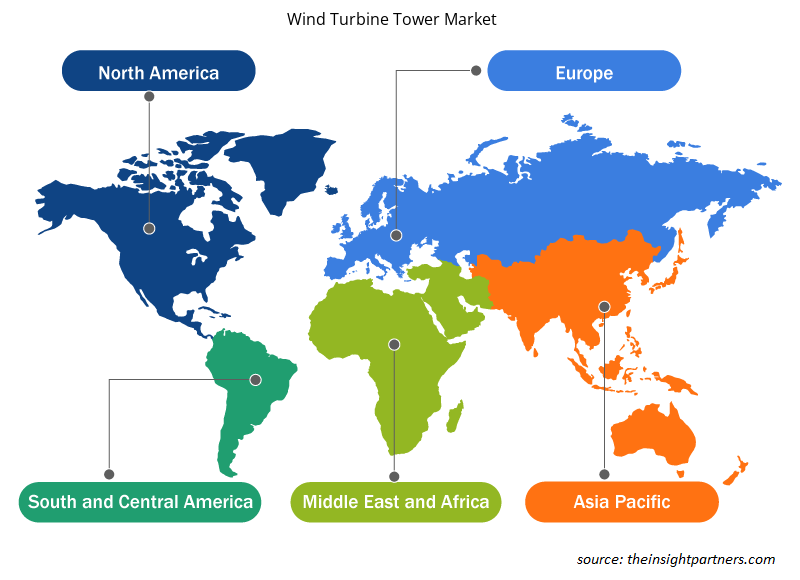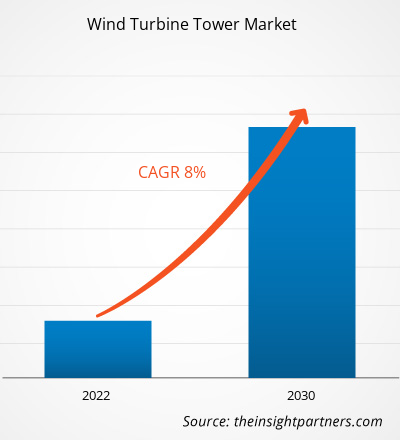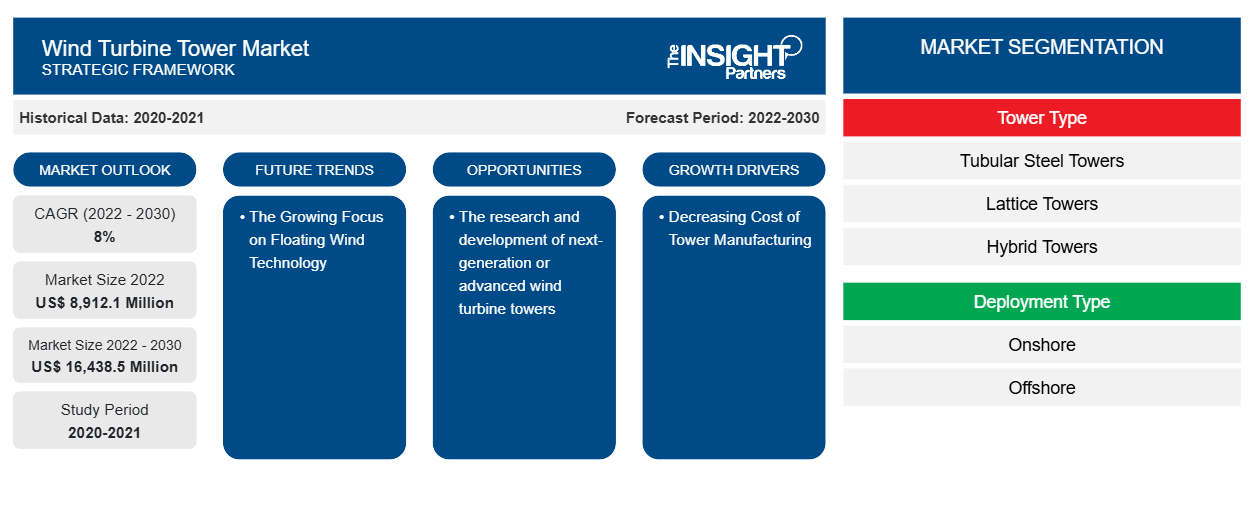Der Markt für Windkrafttürme wurde im Jahr 2022 auf 8.912,1 Millionen US-Dollar geschätzt und soll bis 2030 16.438,5 Millionen US-Dollar erreichen; für den Zeitraum 2022–2030 wird eine durchschnittliche jährliche Wachstumsrate von 8 % erwartet. Die Forschung und Entwicklung von Windkrafttürmen der nächsten Generation oder von fortschrittlicheren Türmen dürften weiterhin wichtige Trends auf dem Markt bleiben.
Marktanalyse für Windkraftanlagentürme
Der globale Markt für Windkrafttürme wird im analysierten Zeitraum voraussichtlich ein beträchtliches Wachstum verzeichnen, da die Zahl der Onshore- und Offshore-Windkraftprojekte, insbesondere an abgelegenen Standorten, zunimmt. Darüber hinaus wird erwartet, dass die staatlichen Vorschriften zur Reduzierung der CO2-Emissionen durch die Konzentration auf die Stromerzeugung durch erneuerbare Energiequellen wie Wind, Sonne, Geothermie und andere das Marktwachstum von 2022 bis 2030 vorantreiben werden. Darüber hinaus werden staatliche Initiativen zur Errichtung von Windparks auf der ganzen Welt voraussichtlich das Marktwachstum in den kommenden Jahren ankurbeln.
Marktübersicht für Windkrafttürme
Mit der wachsenden Bevölkerung und Industrialisierung steigt auch der Energiebedarf auf globaler Ebene. Der Anstieg des Energieverbrauchs steigerte auch den Bedarf an erneuerbarer Energieerzeugung in Entwicklungs- und Industrieländern. Dies hat zu einer steigenden Nachfrage nach Windkraftinfrastruktur auf der ganzen Welt geführt. Die Windkrafterzeugung hat im Vergleich zu anderen erneuerbaren Energiequellen weltweit an Bedeutung und Akzeptanz gewonnen. Fortschrittliche technologische Entwicklungen bei der Konstruktion und Entwicklung von Windkraftblättern, Turbinen, Fundamenten, Turbinentürmen, Schächten und anderen Komponenten haben zu einem deutlichen Fortschritt bei der Nutzung der Windenergie und zur Erzielung maximaler Leistung aus dem verfügbaren Wind beigetragen. Laut der Internationalen Agentur für Erneuerbare Energien (IRENA) erreichte die weltweit installierte Windkapazität bis Ende 2023 1.017 GW gegenüber 825 GW im Jahr 2021. Daher wird erwartet, dass sich ein solcher Anstieg der installierten Windkapazität in den kommenden Jahren aufgrund der Vorteile der Windenergie sowie günstiger Richtlinien, Anreize und Steuererleichterungen fortsetzen wird. Ein solcher Anstieg der Windkraftkapazität auf der ganzen Welt wird voraussichtlich der Haupttreiber auf dem Markt für Windkrafttürme sein.
Passen Sie diesen Bericht Ihren Anforderungen an
Sie erhalten kostenlose Anpassungen an jedem Bericht, einschließlich Teilen dieses Berichts oder einer Analyse auf Länderebene, eines Excel-Datenpakets sowie tolle Angebote und Rabatte für Start-ups und Universitäten.
-
Holen Sie sich die wichtigsten Markttrends aus diesem Bericht.Dieses KOSTENLOSE Beispiel umfasst eine Datenanalyse von Markttrends bis hin zu Schätzungen und Prognosen.
Treiber und Chancen auf dem Markt für Windkraftanlagentürme
Sinkende Kosten für die Turmherstellung begünstigen den Markt
Windtürme werden hauptsächlich aus Stahl hergestellt, der fast 66–79 % der Gesamtkosten einer Turbine ausmacht, gefolgt von Glasfaser , Kunststoff oder Harz (11–16 %), Eisen (5–17 %) und Kupfer und Aluminium (1–2 %). Windturbinentürme bestehen überwiegend aus Stahl. Der wachsende kommerzielle und technologische Fortschritt dürfte die Herstellungskosten von Windturbinentürmen senken. Die instabile Stahlnachfrage auf dem chinesischen Inlandsmarkt und der zunehmende Stahlexport aus China wirken sich auf die Stahlpreise auf globaler Ebene aus. Der kontinuierliche Rückgang der Stahlpreise reduziert die Gesamtbetriebskosten der Windprojekte. Die sinkenden Betriebskosten von Windenergieprojekten wirken sich positiv auf den Windenergiesektor aus, was die Nachfrage nach Windturbinentürmen steigert.
Der wachsende Fokus auf schwimmende Windtechnologie
Bei der schwimmenden Windtechnologie handelt es sich um eine Offshore-Windturbine, die auf einer schwimmenden Struktur im Meer montiert ist, die sicherstellt, dass die Turbine in Wassertiefen Strom erzeugt. Die schwimmende oder Offshore-Windtechnologie ist unter rauen Umweltbedingungen hocheffizient und kann daher enorme Mengen Strom erzeugen. Diese schwimmende Windtechnologie wird weltweit in verschiedenen Ländern wie China, Deutschland, Japan, Großbritannien, Frankreich, Belgien und Dänemark eingesetzt. Die Wachstumsaussichten bei der Einführung der schwimmenden Windtechnologie sind in erster Linie auf einen zunehmenden technologischen Fortschritt, die damit verbundenen Vorteile und die schlüsselfertigen Lösungen verschiedener Dienstleister zurückzuführen. Das wachsende Bewusstsein für die Erreichung sauberer Energieziele in verschiedenen Ländern treibt die Nachfrage nach schwimmender Offshore-Windkraft an, was eine potenzielle Chance für das Wachstum des Marktes für Windturbinentürme darstellt.
Der Bericht des Floating Offshore Wind Centre of Excellence hat 22 Länder identifiziert, die am ehesten dazu bereit sind, wichtige Akteure in der aufkommenden Technologie für erneuerbare Energien zu werden. Im Januar 2022 kündigte die britische Regierung 11 Projekte für erneuerbare Energien an, die jeweils mit bis zu 959,23 Millionen US-Dollar gefördert werden. Damit stellt sie 2,97 Milliarden US-Dollar bereit, um die in Großbritannien erzeugte erneuerbare Energie zu steigern. Solche Investitionen in Offshore- oder schwimmende Windtechnologie auf der ganzen Welt werden voraussichtlich das Marktwachstum in den kommenden Jahren ankurbeln.
Segmentierungsanalyse des Marktberichts für Windkraftanlagentürme
Wichtige Segmente, die zur Ableitung der Marktanalyse für Windkraftanlagentürme beigetragen haben, sind Turmtyp und Einsatztyp
- Basierend auf dem Turmtyp ist der Markt für Windkraftanlagentürme in Stahlrohrtürme, Gittertürme und Hybridtürme unterteilt. Das Segment der Stahlrohrtürme hatte im Jahr 2022 einen größeren Marktanteil.
- Auf der Grundlage der Bereitstellungsart ist der Markt in Onshore und Offshore segmentiert. Das Onshore-Segment hatte im Jahr 2022 einen größeren Marktanteil.
Marktanteilsanalyse für Windkraftanlagentürme nach geografischer Lage
Der geografische Umfang des Marktberichts für Windkrafttürme ist hauptsächlich in fünf Regionen unterteilt: Nordamerika, Asien-Pazifik, Europa, Naher Osten und Afrika sowie Süd- und Mittelamerika.
Der asiatisch-pazifische Raum dominierte 2022 den Markt für Windkrafttürme. Die Region Asien-Pazifik umfasst China, Australien, Indien, Südkorea, Japan und den Rest des asiatisch-pazifischen Raums. Der asiatisch-pazifische Raum ist führend auf dem Markt für Windkrafttürme, da er sich zunehmend auf die Integration erneuerbarer Energiequellen in den Gesamtstrommix konzentriert und das Ziel verfolgt, die durch fossile Brennstoffe verursachte Umweltverschmutzung zu verringern. China nahm im Hinblick auf Onshore- und Offshore-Windkraftanlagen die führende Position auf dem globalen Windmarkt ein. Der zunehmende Fokus der Hersteller von Turbinentürmen auf das Ökosystem der Lieferkette treibt auch das Gesamtwachstum des Marktes für Windkrafttürme maßgeblich voran. Der zunehmend positive Ansatz zur Förderung der Nutzung sauberer Energieressourcen anstelle konventioneller Quellen zur Stromerzeugung durch die Finanzierung erneuerbarer Projekte, Subventionen und Richtlinien treibt die Nachfrage nach Windkrafttürmen in Indien und Australien an.
Regionale Einblicke in den Markt für Windkraftanlagentürme
Die regionalen Trends und Faktoren, die den Markt für Windkrafttürme im Prognosezeitraum beeinflussen, wurden von den Analysten von Insight Partners ausführlich erläutert. In diesem Abschnitt werden auch die Marktsegmente und die Geografie von Windkrafttürmen in Nordamerika, Europa, im asiatisch-pazifischen Raum, im Nahen Osten und Afrika sowie in Süd- und Mittelamerika erörtert.

- Erhalten Sie regionale Daten zum Markt für Windkraftanlagentürme
Umfang des Marktberichts über Windkraftanlagentürme
| Berichtsattribut | Details |
|---|---|
| Marktgröße im Jahr 2022 | 8.912,1 Millionen US-Dollar |
| Marktgröße bis 2030 | 16.438,5 Millionen US-Dollar |
| Globale CAGR (2022 - 2030) | 8 % |
| Historische Daten | 2020-2021 |
| Prognosezeitraum | 2022–2030 |
| Abgedeckte Segmente |
Nach Turmtyp
|
| Abgedeckte Regionen und Länder |
Nordamerika
|
| Marktführer und wichtige Unternehmensprofile |
|
Marktteilnehmerdichte für Windkraftanlagen: Auswirkungen auf die Geschäftsdynamik verstehen
Der Markt für Windturbinentürme wächst rasant, angetrieben durch die steigende Nachfrage der Endnutzer aufgrund von Faktoren wie sich entwickelnden Verbraucherpräferenzen, technologischen Fortschritten und einem größeren Bewusstsein für die Vorteile des Produkts. Mit steigender Nachfrage erweitern Unternehmen ihr Angebot, entwickeln Innovationen, um die Bedürfnisse der Verbraucher zu erfüllen, und nutzen neue Trends, was das Marktwachstum weiter ankurbelt.
Die Marktteilnehmerdichte bezieht sich auf die Verteilung der Firmen oder Unternehmen, die in einem bestimmten Markt oder einer bestimmten Branche tätig sind. Sie gibt an, wie viele Wettbewerber (Marktteilnehmer) in einem bestimmten Marktraum im Verhältnis zu seiner Größe oder seinem gesamten Marktwert präsent sind.
Die wichtigsten auf dem Markt für Windkraftanlagentürme tätigen Unternehmen sind:
- Vestas Wind Systems A/S
- Siemens Gamesa Renewable Energy
- SA
- Valomont Industries
- Einschl.
- Marmen Inc
Haftungsausschluss : Die oben aufgeführten Unternehmen sind nicht in einer bestimmten Reihenfolge aufgeführt.

- Überblick über die wichtigsten Akteure auf dem Markt für Windkraftanlagentürme
Neuigkeiten und aktuelle Entwicklungen zum Markt für Windkrafttürme
Der Markt für Windkrafttürme wird durch die Erhebung qualitativer und quantitativer Daten nach Primär- und Sekundärforschung bewertet, die wichtige Unternehmensveröffentlichungen, Verbandsdaten und Datenbanken umfasst. Nachfolgend sind einige der Entwicklungen auf dem Markt für Windkrafttürme aufgeführt:
- Der erste Auftrag für den GreenerTower ist bereits abgeschlossen. RWE und Siemens Gamesa haben vereinbart, 36 GreenerTowers im 1.000-MW-Offshore-Windenergieprojekt Thor in Dänemark zu errichten. Insgesamt sollen ab 2026 etwa 72 Offshore-Windturbinen vom Typ SG 14-236 DD installiert werden. (Quelle: Siemens Gamesa Renewable Energy, SA, Pressemitteilung, April 2023)
- Orsted und Vestas, weltweit führende Anbieter erneuerbarer Energien, haben eine kommerzielle Nachhaltigkeitspartnerschaft angekündigt. Ørsted wird voraussichtlich in allen gemeinsamen Offshore-Windprojekten Windturbinentürme aus kohlenstoffarmem Stahl und Rotorblätter aus recycelten Materialien von Vestas beziehen. (Quelle: NN, Inc, Pressemitteilung, Juni 2023)
Marktbericht zu Windkraftanlagentürmen – Abdeckung und Ergebnisse
Der Bericht „Marktgröße und Prognose für Windkraftanlagentürme (2020–2030)“ bietet eine detaillierte Analyse des Marktes, die die folgenden Bereiche abdeckt:
- Marktgröße und Prognose für Windkraftanlagentürme auf globaler, regionaler und Länderebene für alle wichtigen Marktsegmente, die im Rahmen des Berichts abgedeckt sind
- Markttrends für Windkrafttürme sowie Marktdynamik wie Treiber, Einschränkungen und wichtige Chancen
- Detaillierte PEST- und SWOT-Analyse
- Marktanalyse für Windkrafttürme, die wichtige Markttrends, globale und regionale Rahmenbedingungen, wichtige Akteure, Vorschriften und aktuelle Marktentwicklungen umfasst
- Branchenlandschaft und Wettbewerbsanalyse, einschließlich Marktkonzentration, Heatmap-Analyse, prominenten Akteuren und aktuellen Entwicklungen auf dem Markt für Windkrafttürme
- Detaillierte Firmenprofile
- Historische Analyse (2 Jahre), Basisjahr, Prognose (7 Jahre) mit CAGR
- PEST- und SWOT-Analyse
- Marktgröße Wert/Volumen – Global, Regional, Land
- Branchen- und Wettbewerbslandschaft
- Excel-Datensatz
Aktuelle Berichte
Verwandte Berichte
Erfahrungsberichte
Grund zum Kauf
- Fundierte Entscheidungsfindung
- Marktdynamik verstehen
- Wettbewerbsanalyse
- Kundeneinblicke
- Marktprognosen
- Risikominimierung
- Strategische Planung
- Investitionsbegründung
- Identifizierung neuer Märkte
- Verbesserung von Marketingstrategien
- Steigerung der Betriebseffizienz
- Anpassung an regulatorische Trends























 Kostenlose Probe anfordern für - Markt für Windturbinentürme
Kostenlose Probe anfordern für - Markt für Windturbinentürme